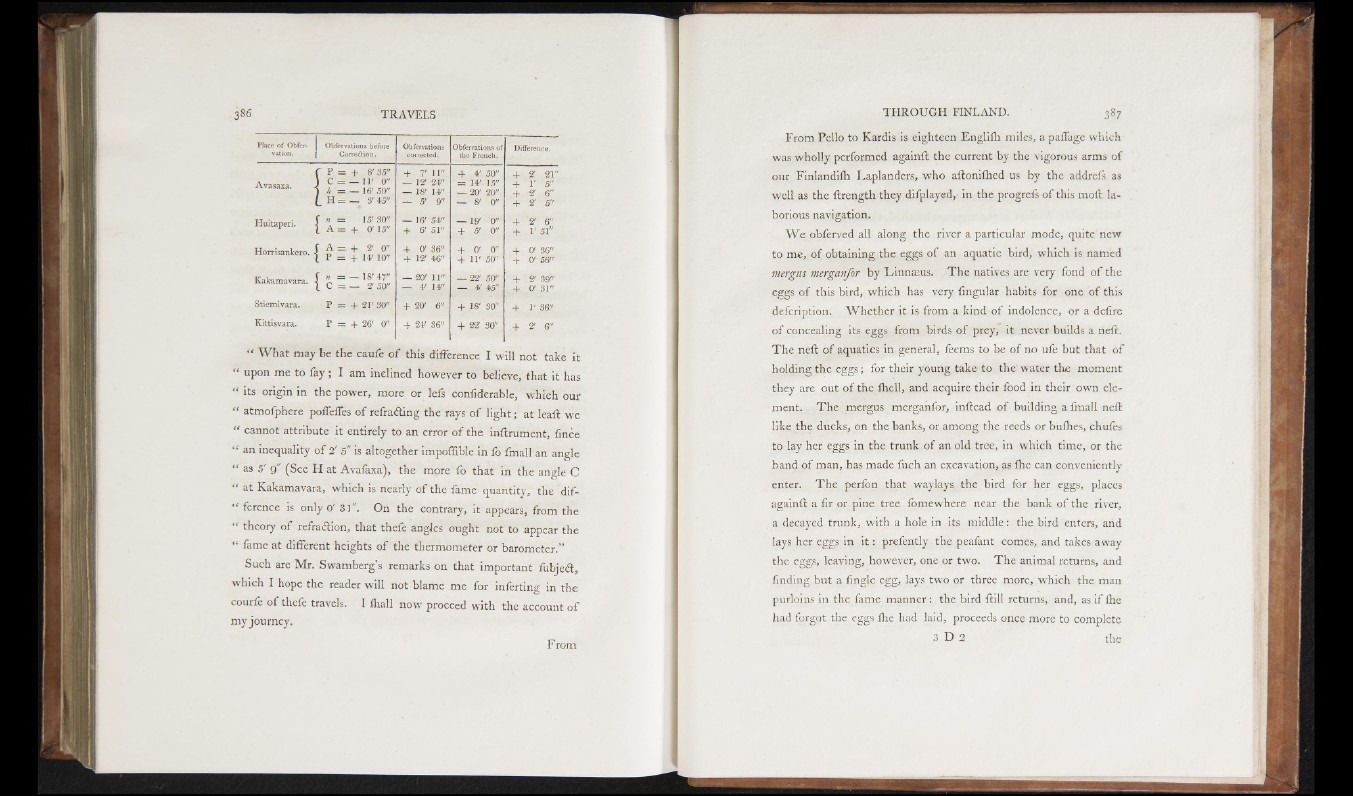
Place of Obfer- Obfervations before Obfervations Obfervations vation. of Differenr.«. Corredtion. j corrected. the French.
f I = 8 8' 3 5 " + 7' 11" + 4' 50" + 2' 21"
Avasaxa. -<1 c = — 1 1 ' ' 0" — 12' 24" = 14' 15" + 1 ' 5"
= — 16' 50" —. 18' 14" — 20' 20" + 2' 6"
L H = — 3' 45" — 5' 9" 8' 0" '+ 2' 5''
Huitaperi. i n
L A
=
+
15' 30"
O' 15" +
16'
6'
54"
51"; +
197
5'
0 0
+
+
2'
1'
6"
51w
Horrisankero. ■A Jg + 2' 0" + O' 36" + O' 0" + O' 36"
P =: + 14/ 10" + 12' 46" + 11' 50" + 0' 56"-
Kakamavara. •‘ n = — 18' 47" — 20t 11" _ 22' 50" + 2' 39^''
I c = — 52' 50" — 4' 14" — 4' 45" + O' 31"
Stiemivara. P = + 2 1 ' 30" + 20' 6" + 18' 30" + 1' 36?'
Kittisvara. P = + 26' 0" + 24' 36" + 22' 30" + 2' 6"
“ W h at may be the caufe o f this difference I will not take it
“ upon me to fa y ; I am inclined however to believe, that it has
“ its origin in the power, more or lefs confiderable, which our
“ atmoiphere poffeffes o f refracting the rays o f light; at leaft we
“ cannot attribute it entirely to an error o f the inftrument, fince
“ an inequality o f 2' 5" is altogether impoffible in fo fmall an angle
“ as 5' 9" (See H at Avafaxa), the mpre fo that in the angle C
“ at Kakamavara, which is nearly o f the fame quantity, the dif-
“ ference is only o' 31". On the contrary, it appears, from the
“ theory o f refradion, that thefe angles ought not to appear the
“ fame at different heights o f the thermometer or barometer.”
Such are Mr. Swamberg’s remarks on that important fubjed,
which I hope the reader will not blame me for inferting in the
courfe o f thefe travels. I fhall now proceed with the account o f
my journey.
From
From Pello to Kardis is eighteen Englifh miles, a paffage which
was wholly performed againft the current by the vigorous arms of
our Finlandifh Laplanders, who aflonifhed us by the addrefs as
well as the ftrength they difplayed,- in the progrefs o f this moil laborious
navigation.
W e obferved all along the river a particular mode, quite new
to me, o f obtaining the eggs o f an aquatic bird, which is named
mergus merganfor by Linnaeus. T he natives are very fond o f the
eggs o f this bird, which has very fingular habits for one o f this
defcriptionv Whether it is from a kind o f indolence, or a deiire
o f concealing its eggs from birds o f prey, it never builds a neit.
The nell of aquatics in general, ieems to be of no uie but that o f
holding the eggs; for their young take to the water the moment
they are out of the ihell, and acquire their food in their own element.
T h e mergus merganfor, inifead o f building a fmall neft
like the ducks, on the banks, or among the reeds or buihes, chufes
to lay her eggs in the trunk o f an old tree, in which time, or the
band o f man, has made fuch an excavation, as Ihe can conveniently
enter. The perfon that waylays the bird for her eggs, places
againft a fir or pine tree iomewhere near the bank o f the river,
a decayed trunk, with a hole in its middle : the bird ^enters, and
lays her eggs in i t : prefently the pealant comes, and takes away
the eggs, leaving, however, one or two. The animal returns, and
finding but a fingle egg, lays two or three more, which the man
purloins in the fame manner: the bird ftill returns, and, as if ihe
had forgot the eggs ihe had laid, proceeds once more to complete
3 D 2 the